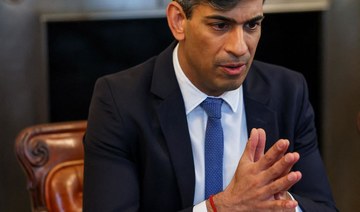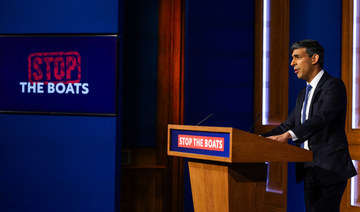GAZA: Israel declared its determination Wednesday to press on with its Gaza war “with or without international support,” after it came under mounting pressure even from key backer the United States.
Now in its third month, the war was launched after the unprecedented October 7 attacks on Israel by Palestinian militant group Hamas that officials say killed 1,200 people, mostly civilians.
It has left Gaza in ruins, killing more than 18,600 people, mostly women and children, according to the Hamas-run health ministry, and causing “unparallelled” damage to roads, schools and hospitals.
The day after the UN General Assembly overwhelmingly backed a non-binding resolution for a cease-fire, more strikes hit Gaza and battles raged, especially in Gaza City, the biggest urban center, and Khan Yunis and Rafah in the south, AFP correspondents said.
Cold wintery rains lashed the territory, where the UN estimates 1.9 million of Gaza’s 2.4 million population have been displaced, living in makeshift tents as vital supplies of food, drinking water, medicines and fuel run low.
Camped with thousands in the grounds of the Al-Aqsa Martyrs hospital in central Gaza, Ameen Edwan said his family was unable to sleep.
“Rainwater seeped in. We couldn’t sleep. We tried to find nylon covers but couldn’t find any, so we resorted to stones and sand” to keep the rain out, he told AFP.
The United Nations warned the spread of diseases — including meningitis, jaundice, impetigo, chickenpox and upper respiratory tract infections — had intensified.
The World Health Organization said 107 trucks carrying humanitarian aid had entered the besieged territory from Egypt, well below the daily average of 500 before October 7.
Air raid sirens wailed in Sderot and other southern Israeli communities near Gaza as Palestinian militants fired rockets, most of which were intercepted.
Israel’s military said sirens sounded in Ashdod city north of Gaza and in the Lakhish area. Social media footage showed a large fragment of an intercepted rocket had hit a supermarket.
The army said an air strike had hit a militant cell in Gaza City’s Shejaiya district “that was en route to launch rockets toward Israel.”
In Khan Yunis, a family mourned father of seven Fayez Al-Taramsi, killed in a strike.
“How are we going to live after him?” one of his daughters said, crying and clutching his bloodied shirt. “He brought us to life.”
In the October 7 attack — the deadliest in Israel’s 75-year history — Hamas also seized around 240 hostages.
Determined to destroy Hamas and bring the hostages home, Israel began a devastating aerial and ground offensive.
It has lost 115 soldiers, including 10 in northern Gaza on Tuesday, its deadliest day since the ground assault began on October 27.
The UN General Assembly passed a resolution Tuesday demanding a cease-fire, backed by 153 of 193 nations — surpassing the 140 or so that have routinely condemned Russia for invading Ukraine.
While Washington voted against, the resolution was supported by allies Australia, Canada and New Zealand, who, in a rare joint statement, said they were “alarmed at the diminishing safe space for civilians in Gaza.”
US President Joe Biden told a campaign event Israel had “most of the world supporting it” immediately after October 7, but “they’re starting to lose that support by the indiscriminate bombing that takes place.”
Biden, who toned down his comments later, on Wednesday met with families of American hostages from those the militants seized.
Despite the criticism from its main ally, Israel vowed to pursue its war.
“Israel will continue the war against Hamas with or without international support,” said Foreign Minister Eli Cohen.
“A cease-fire at the current stage is a gift to the terrorist organization Hamas, and will allow it to return and threaten the residents of Israel,” Cohen told a visiting diplomat, quoted by his ministry.
Israeli Prime Minister Benjamin Netanyahu later said Israel would persevere.
“We will continue until the end. There is no question at all. I say this in light of great pain, but also in light of international pressure. Nothing will stop us. We are going until the end, until victory, nothing less than that,” he said in a video statement.
Biden’s national security adviser, Jake Sullivan, will travel to Israel on Thursday to meet Netanyahu, who has said there is “disagreement” with Washington over how a post-conflict Gaza would be governed.
Hamas chief Ismail Haniyeh on Wednesday said that any plan for post-war Gaza that does not involve the Palestinian militant group “or the resistance factions is a delusion.”
Tuesday’s UN vote came as Philippe Lazzarini, head of its Palestinian refugee agency, said Gazans were “running out of time and options.”
The United States and Britain announced a new round of sanctions against Hamas over the October 7 attack, targeting “key officials who perpetuate Hamas’s violent agenda.”
Gaza’s hospital system is in ruins, and Hamas authorities said vaccines for children had run out, warning of “catastrophic health repercussions.”
The World Bank in a new analysis warned that “the loss of life, speed and extent of damages... are unparallelled.”
The Hamas-controlled health ministry said Israeli forces opened fire on wards of Kamal Adwan hospital in north Gaza, raising fears for the safety of 12 children in paediatric care.
The army has yet to comment, but Israel has repeatedly accused Hamas of using hospitals, schools, mosques and vast tunnel systems beneath them as military bases — claims the group has denied.
Fears of the conflict broadening continued, with daily exchanges of fire along Israel’s border with Lebanon, where Hezbollah is based, and other Iran-backed groups targeting US and allied forces in Iraq and Syria.
Israeli President Isaac Herzog warned Yemen’s Iran-backed Houthi rebels had “crossed a red line,” after repeatedly launching missiles and drones toward Israel and cargo ships in the Red Sea.
Israel to pursue Gaza war ‘with or without international support’
https://arab.news/b26e9
Israel to pursue Gaza war ‘with or without international support’
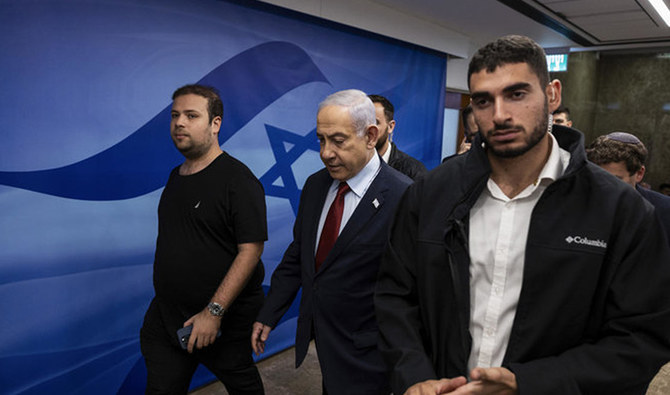
- Israel has come under mounting pressure even from key backer United States
- “We will continue until the end. There is no question at all,” Netanyahu says
Syrian asylum-seeker plans suicide if sent to Rwanda
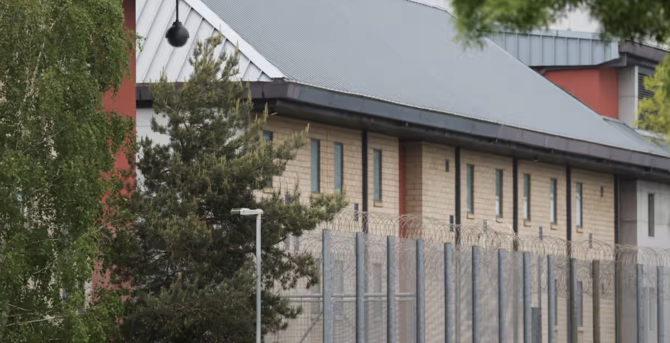
- Man identified as Khaled among more than 100 people set to be sent to East African country
- ‘I will not be safe in Rwanda. If they manage to send me there, I will kill myself on arrival’
LONDON: A Syrian asylum-seeker in the UK set to be deported to Rwanda has said he will kill himself if sent to the East African country.
The man, identified as Khaled, is being held at Colnbrook Immigration Removal Centre with a number of other people due to be sent to Rwanda.
He told The Guardian: “Everyone is so stressed in here because of Rwanda. We can’t eat and we can’t sleep. I was displaced in Syria for nine years and was imprisoned there and I was also detained and tortured in Libya.
“Being in detention is very triggering for me. What matters to asylum-seekers is to be safe. I will not be safe in Rwanda. If they manage to send me there, I will kill myself on arrival in that country.”
Khaled has been in the UK since 2022, and discovered he could be sent to Kigali for the first time in February 2023. He was detained with a view to removal last week.
“They arrested me and put me in handcuffs in a police cell. The same thing happened to two other people who were reporting — Iraqi Kurds. After we were taken out of the cell we were handcuffed again and taken in a van to the detention centre,” he said.
“I have been trying to see a doctor in the detention centre because of an infection in my leg I need antibiotics for but so far I haven’t managed to get an appointment.”
Another asylum-seeker who did not give his name, and who arrived in the UK from Sudan in 2022, told The Guardian that he had traveled via the Mediterranean and the boat he had been on almost sank.
“I would have been happy to claim asylum in Italy but Italian officials did not fingerprint me and told me to move on to France. There I was told it would be four years before they could consider my asylum claim so I waited in the jungle in Calais to cross to the UK. Crossing the Channel in an overcrowded boat was even more terrifying than crossing the Mediterranean,” he said.
“When I heard about the government’s plans to send asylum-seekers to Rwanda at the beginning of 2023 I was very frightened.
“I escaped from an African country because it was not safe and I am very scared to be deported to another African country because I know it will not be safe for me.
“I was arrested last week when I went to report in Newcastle. They didn’t mention Rwanda until I reached the detention centre and at first just said ‘We are deporting you to a safe third country.’”
The two men told The Guardian that they were struggling to contact legal representatives while in detention, with a seven-day deadline imposed by the Home Office for those wishing to appeal the decision to send them to Rwanda.
The charity Care4Calais has published data suggesting that of the more than 100 people detained to be sent to Rwanda, most come from war zones.
The charity’s head of legal access, Hannah Harwood, said: “The people detained have not had their asylum claims processed, and it’s clear from the first cohort we are in contact with that if their claims were processed they would probably be granted refugee status in the UK. It reaffirms how shameful the Rwanda plan is and why it must be stopped.”
A Home Office spokesperson said: “We take the welfare of people in our care extremely seriously. There are robust safeguarding measures in place to ensure everyone is treated with dignity and has the support they need.
“All detained individuals have access to a mobile phone, internet and landline telephones so they can keep in contact with friends, family and other support.”
Philippines seeks to position itself as top tourism destination at Arabian Travel Market
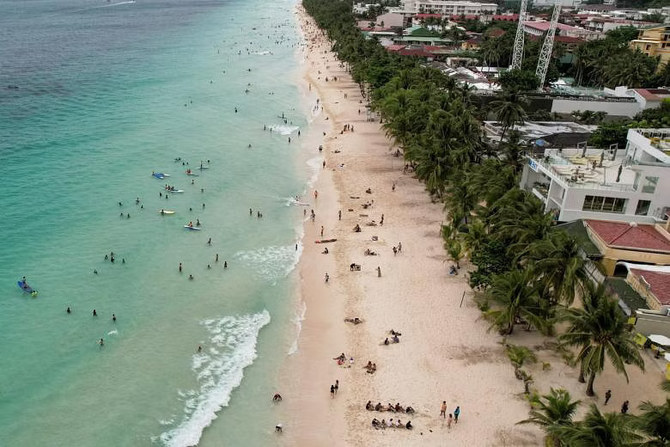
- Philippines has recorded 10 percent increase in visitors arriving from Gulf countries this year
- The country wants to become a preferred destination in Asia and the world
MANILA: The Philippines is working to attract more visitors from the Middle East and position itself as a preferred destination for international travelers, its tourism stakeholders said ahead of the Arabian Travel Market in Dubai.
More than 2,300 exhibitors and delegates from over 165 countries are joining the annual Arabian Travel Market, which this year will take place from May 6 to 9 at the Dubai World Trade Center.
In the Philippines, known for its white sandy beaches, diving spots and diverse culture, tourism is a key sector, contributing nearly 13 percent, or about $44 billion, to its gross domestic product in 2019.
The Department of Tourism will be leading the Philippine delegation in Dubai, as officials set their eyes on promoting the country’s best tourism to the international market.
“We look forward to these opportunities to share the Filipino story to the rest of the world … and to reinforce the Philippines’ position as a preferred destination and top-of-mind choice for travelers,” Secretary of Tourism Christina Garcia Frasco said in a statement.
With its participation at the Arabian Travel Market, the Philippines hopes to sustain the momentum from increased tourist arrivals from the Middle East, she added.
The Philippine tourism industry will not only promote their strengths, such as their tropical and natural attractions, but also diverse offerings in gastronomy and culture, as well as the Filipino tourism workers, “who serve as our best asset for their distinct hospitality and warmth,” Frasco said.
The Philippines has welcomed more 2 million international travelers since the beginning of the year, according to data from the tourism department. This includes a 10 percent increase in visitors arriving from Gulf countries, especially Saudi Arabia and the UAE, which has been among the Philippine government’s key emerging-market targets.
“There’s been a remarkable surge in outbound tourism from the Middle East, particularly from Gulf Cooperation Council countries … We see a growing appetite for international travel among GCC citizens and we see this trend continuing to rise in the coming years,” said Maria Margarita Montemayor Nograles, chief operating officer of the Tourism Promotions Board.
“This is one of the major reasons why we are doubling down on our efforts to maintain and enhance our presence in the Middle East. With our continued participation at the ATM, we aim to position the Philippines as a top-of-mind destination in Asia.”
Tourists from the Middle East are growing more important for some Filipino tourism operators, and represent a significant segment of their clientele, said Manih Karay, president of CTPH Tour.
“To appeal to tourists from Arab countries and promote the Philippines, we highlight the country’s natural beauty, rich cultural heritage, and warm hospitality … Their interest in exploring new destinations and cultural experiences aligns well with our commitment to providing inclusive and diverse travel services,” Karay told Arab News.
Arab tourists also contribute to the growth of the Philippines’ tourism industry, Karay said, adding that they foster cultural exchange and economic development.
“Their visits not only enrich our travel experiences but also promote mutual understanding and appreciation among different cultures,” she said.
Suspected Kashmir rebels kill Indian air force corporal
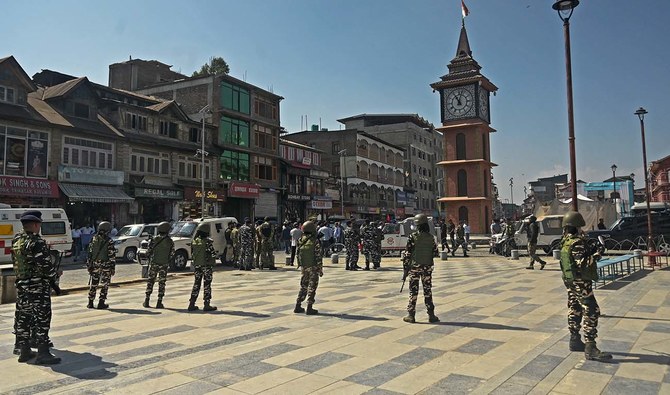
- Suspected rebels ambushed military convoy in Indian-administered Kashmir, Indian Air Force says
- Since 1989, rebel groups opposed to Indian rule have waged insurgency in disputed territory
SRINAGAR, India: An Indian air force member was killed and four more injured when suspected rebels ambushed a military convoy in Indian-administered Kashmir, an official statement said, as campaigning for national elections continues in the disputed territory.
The convoy was attacked by an unknown number of armed militants who sprayed automatic rifle fire toward at least one air force truck in the mountainous Poonch area, 200 kilometers (124 miles) south of the main city of Srinagar, the air force said in a statement.
Five air force personnel were hit in the firefight late Saturday and “one Air Warrior succumbed to his injuries later,” it said, identifying the dead man as a corporal.
A neighboring constituency took part in the first phase of India’s general election on April 19, and Poonch voters were originally scheduled to cast their ballots this week but the Election Commission of India has postponed the polling to May 25 because of inclement weather in recent days.
Kashmir has been divided between India and Pakistan since their independence in 1947, with both claiming the high-altitude territory in full but administering it in parts.
Since 1989, rebel groups opposed to Indian rule have waged an insurgency in Indian-controlled Kashmir, demanding either independence or a merger with Pakistan.
The conflict has left tens of thousands of civilians, soldiers and militants dead.
Rebel activity in the territory has registered an uptick since last month as campaigning for the elections picked up in the restive region.
In April, three suspected rebels were killed and a police officer and three soldiers wounded in three separate clashes across the territory.
Violence has drastically dropped since 2019, when Prime Minister Narendra Modi’s government revoked the region’s limited autonomy and stepped up a security chokehold.
Voting in India’s six-week-long national election, which started last month, will end on June 1.
Driver dies after crashing into White House perimeter gate, Secret Service says

- The driver was not immediately identified
WASHINGTON: A driver died after crashing a vehicle into a gate at the White House Saturday night, authorities said.
The driver was found dead in the vehicle following the crash shortly before 10:30 p.m. at an outer perimeter gate of the White House complex, the US Secret Service said in a statement.
Security protocols were implemented but there was no threat to the White House, the agency said.
The driver was not immediately identified.
The Secret Service will continue to investigate the matter, while turning over the fatal crash portion of the investigation to the Washington Metropolitan Police Department, the agency said.
Fake videos of Modi aides trigger political showdown in India election

- Indian police arrest nine people for circulating fake video of Indian Home Minister Amit Shah
- With more than 800 million Internet users, tackling misinformation in India is a huge challenge
BENGALURU/LUCKNOW: Manipulated videos are taking center stage as campaigning heats up in India’s election, with fake clips involving two top aides of Prime Minister Narendra Modi triggering police investigations and the arrest of some workers of his rival Congress party.
In what has been dubbed as India’s first AI election, Modi said last week fake voices were being used to purportedly show leaders making “statements that we have never even thought of,” calling it a conspiracy “to create tension in society.”
Indian police — already investigating the spread of fake videos showing Bollywood actors criticizing Modi — are now investigating a doctored online clip that showed federal home minister Amit Shah saying the ruling Bharatiya Janata Party will stop certain social guarantees for minorities, a subject sensitive for millions of voters.
Shah retorted on X, posting his “original” and the edited “fake” speech and alleging — without providing any evidence — that the main opposition Congress was behind the video it created to mislead the public. The minister said “directions have been issued to the police to address this issue.”
Indian police arrested at least nine people, including six members of Congress’ social media teams, in the states of Assam, Gujarat, Telangana and New Delhi last week for circulating the fake video, according to police statements.
Five of the Congress workers were released on bail, but the most high-profile arrest made by the cybercrime unit of New Delhi police came on Friday, when they detained a Congress national social media coordinator, Arun Reddy, for sharing the video. New Delhi is one region where Shah’s ministry directly controls police. Reddy has been sent into three-day custody.
The arrest has sparked protests from Congress workers with many posting on X using the #ReleaseArunReddy tag. Congress lawmaker Manickam Tagore said the arrest was an example of “authoritarian misuse of power by the regime.”
Congress’ head of social media, Supriya Shrinate, did not respond to messages and an email seeking comment.
MISINFORMATION
India’s election from April 19 to June 1 will be the world’s largest democratic event. With nearly a billion voters and more than 800 million Internet users, tackling the spread of misinformation is a high stakes job. It involves round-the-clock monitoring by police and election officials who often issue take down orders to Facebook and X as investigations start.
In India’s most populous state of Uttar Pradesh, more than 500 people keep tabs on online content, flagging controversial posts and coordinating with social media companies for their removal when needed, police chief Prashant Kumar told Reuters on Saturday.
Another fake video that sparked a storm last week showed Yogi Adityanath, the state’s chief minister, criticizing Modi for not doing enough for families of those who died in a 2019 militant attack. Though fact checkers said the video was created using different parts of an original clip, state police called it an “AI generated, deepfake.”
Using Internet address tracking, state police arrested a man named Shyam Gupta on May 2 who had shared the fake video post on X a day earlier, receiving over 3,000 views and 11 likes.
The police have accused Gupta of forgery and promoting enmity under Indian law provisions that can carry a jail term of up to seven years if convicted. Reuters could not reach him as he is currently serving a 14-day custody period.
“This person is not a tech guy. Had he been tech savvy, arresting him quickly would not have been possible,” said police officer Kumar.



